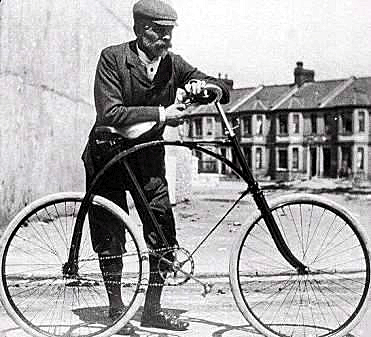 Bicycles
have been an important part of American life since the first crude
one appeared in 1818. People use them for transportation, racing,
touring, as well as for everyday exercise. In China and The
Netherlands, they’re an inexpensive way to get around.
Bicycles
have been an important part of American life since the first crude
one appeared in 1818. People use them for transportation, racing,
touring, as well as for everyday exercise. In China and The
Netherlands, they’re an inexpensive way to get around.
By definition, a bicycle is a vehicle with two wheels, front and
back, with a seat or saddle between, propelled by means of pedals
working on a crank shaft. However, this wasn’t always the case. The
first bicycle, invented by Baron Karl von Drais in 1817, had wooden
wheels, no pedals and no tires. People propelled themselves on it by
pushing on the ground with their feet. Riders steered one of these
contraptions, called “pedestrian curricles,” using handle bars, much
like they do today. Though the Baron added front-wheel ratchets in
1821, pedals didn’t come along until about 1860.
Bicycle History
Legends and lore fill bicycle history. For instance, Leonardo da
Vinci did not invent the bicycle in 1492. The drawings he allegedly
made proved to be a hoax that dates to the 1970s. The true history
of the bicycle can be traced to 1817 and the invention of what Baron
von Drais dubbed his “walking machine.” It consisted of two inline
wheels of the same size, mounted on a frame straddled by the rider.
In the mid-1860s, a machine propelled by foot pedals attached
directly to the front wheel came about. People called these
“velocipedes,” but they were only popular for a decade or so. The
earliest were all wood. Later ones had sturdy metal frames and
wooden wheels which made for a rough ride on cobblestone streets or
country lanes, thus riders gave them a more appropriate
name—“boneshakers.” Although popular for a while, the bone-shaker
was awkward and inefficient, so its popularity waned quickly.
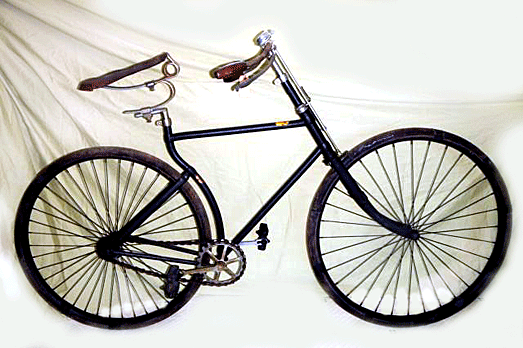
The Dexter velocipede of 1869 at long last had brakes. But its seat
was too low to be comfortable. The front wheels were a little higher
than the back ones.
The “Ordinary” Debuts
In 1871, James Starley designed the high wheel bicycle in England.
He crafted his first model entirely of metal. It was an efficient
machine and quickly became popular. As with the boneshaker, the
pedals were attached directly to the front wheel, but now with solid
rubber tires the front wheel produced a much smoother ride. Since
the large wheel went a good distance on one revolution, a rider on a
high wheel bicycle could go farther and faster with less pedaling
than a person on a bike with a smaller wheel. This design was the
first to be called a bicycle families could afford one. People
referred tp this machine as an "ordinary bicycle." Soon they simply
called it "the ordinary."
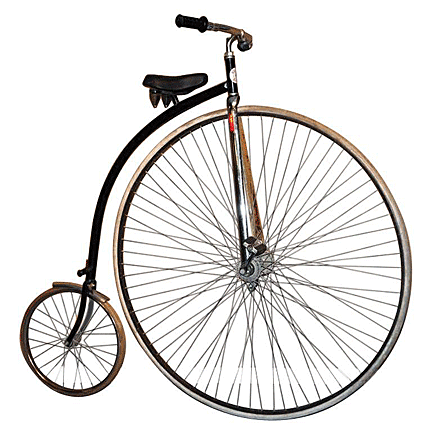 People
also called high wheel bicycles "Penny farthings" for the big wheel
was compared in size to the Victorian penny and the smaller rear one
to the tiny farthing. They were extremely dangerous to ride for
brakes had not yet been added. Lallemont invented pedals which
turned on their pins. He also added a saddle on a curved spring.
People
also called high wheel bicycles "Penny farthings" for the big wheel
was compared in size to the Victorian penny and the smaller rear one
to the tiny farthing. They were extremely dangerous to ride for
brakes had not yet been added. Lallemont invented pedals which
turned on their pins. He also added a saddle on a curved spring.
The ordinary made its debut in America at the 1876 Centennial
Exposition in Philadelphia.
One of the pitfalls of the high wheel’s design was the tendency to
dump the rider over on his head whenever the bike encountered an
obstacle in the roadway. Taking a header was common. The familiar
expression originated in bicycling since applying the hand brake to
stop the high wheel could also flip the rider over on his head.
Riding downhill on a high wheel was especially dangerous.
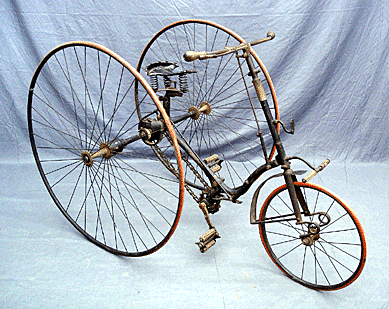 Because
of the dangers of the ordinary, women didn’t participate in
bicycling except for a few who rode high-wheel tricycles. Tricycles
eliminated many hazards for women and also for gentlemen who were
less agile and sporting. Other developments in design of the
high-wheel bicycle soon moved the larger wheel to the back and other
inventions made high-wheel safety bicycles less prone to throwing
the rider headfirst over the handles.
Because
of the dangers of the ordinary, women didn’t participate in
bicycling except for a few who rode high-wheel tricycles. Tricycles
eliminated many hazards for women and also for gentlemen who were
less agile and sporting. Other developments in design of the
high-wheel bicycle soon moved the larger wheel to the back and other
inventions made high-wheel safety bicycles less prone to throwing
the rider headfirst over the handles.
The development of the chain and sprocket allowed bicycles to evolve
with wheels of the same size. This provided increased safety and
efficiency for the rider. This immediately allowed women to use
bicycles. Unfortunately, the early models did not provide any means
of absorbing the shock of the ride. so it made for a choice between
the comfort of the high wheel and the safety of the safety designs.
The high wheel safety bicycle came along later as a result of the
hazards of riding high. Easily recognized because it has the small
wheel in front, it eliminated the worry of taking a header but it
had problems of its own. Most riders find it difficult, while its
design makes it easy for a rider to tumble off backwards.
As bicycle designs evolved, the use of chains and gears enabled
makers to eliminate high wheels and lower the eats. Tires, safety,
convenience and efficiency improved, but Nichols maintains he seat
is one thing bicycle manufacturers still haven't changed for the
better.
The Air-Filled Tire
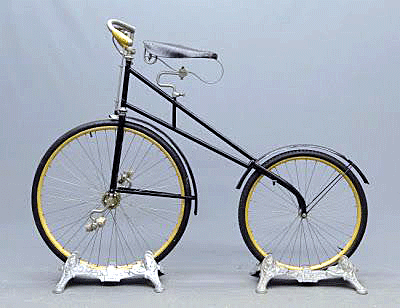 n
1888, an Irish veterinarian named Dunlop developed a pneumatic
air-filled tire that provided both comfort and efficiency. Adding
that to a new diamond frame and more efficient chain drives, the
newly designed safety bicycle soared to new heights of popularity,
especially among women. In fact, Susan B. Anthony in 1896
proclaimed, "The bicycle has done more for the emancipation of women
than anything else in the 19th century." The 1890s became the golden
age of the bicycle and millions of bicycles were manufactured in
that decade.
n
1888, an Irish veterinarian named Dunlop developed a pneumatic
air-filled tire that provided both comfort and efficiency. Adding
that to a new diamond frame and more efficient chain drives, the
newly designed safety bicycle soared to new heights of popularity,
especially among women. In fact, Susan B. Anthony in 1896
proclaimed, "The bicycle has done more for the emancipation of women
than anything else in the 19th century." The 1890s became the golden
age of the bicycle and millions of bicycles were manufactured in
that decade.
The "safeties” have many rare and valuable forms. For example, the
Sanauizzis of 1910 had metal wheels with bamboo spokes. The lvoer's
tricycles eventually became "bicycles built for two."
The era of the bicycle ended after the automobile arrived at the
turn of the 1900s and the bicycle became more of a child's toy. The
1930s ushered in what collectors call the era of classic bicycles,
which had a new balloon tire. The newer, more colorful and artsy
designs appealed to kids because they included elements taken from
automobiles and motorcycles, a reverse of what the bicycle had
provided for the motorcycle and automobile in the 19th century.
These classic bicycle designs are now extremely popular collectibles
with baby boomers who have fond memories of their preteen years on
their classic bicycle.
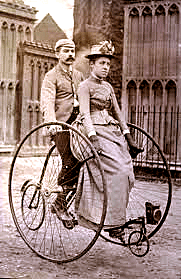 A
bicycle built for two, the “Sociable” was only one of several
variations of the somewhat dangerous but popular 19th-century
high-wheeler, whose brakes were either nonexistent or very crude.
A
bicycle built for two, the “Sociable” was only one of several
variations of the somewhat dangerous but popular 19th-century
high-wheeler, whose brakes were either nonexistent or very crude.
The bottom line for bicycle collectors is cost. High wheels
typically cost $3,000 and up. Even a reproduction high wheel bicycle
costs at least $3,000.
There's more to collecting bicycles than finding and buying them.
While some people collect antique bicycles for display, others buy
them to ride. A large group of collectors of antique and classic
bicycles are constantly on the lookout for designs of yesteryear.
These dedicated enthusiasts make regular visits to antique shops and
shows, flea markets and auctions seeking ready-to-ride bikes and
bike parts for a restoration project.
